How to Complete the Square - Answers
The answers are in BOLD below.
NOTE: The transcript from the video is listed below the quiz for your reference.
1. Completing the square changes a quadratic equation in standard form into one in...
- Vertex form
- Intercept form
- Standard form
- Factored form
- Completed form
2.
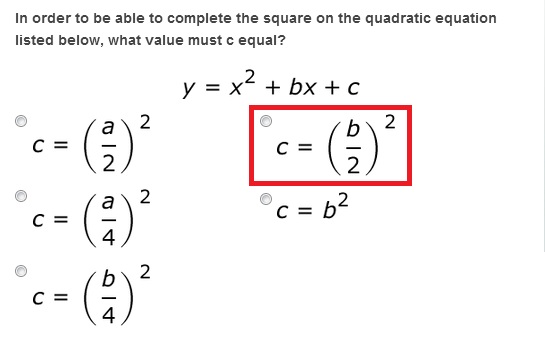
3. When you complete the square, you are turning a quadratic trinomial into what?
- A polynomial
- A monomial
- A perfect square binomial
- A cubic trinomial
- A quartic trinomial
4.
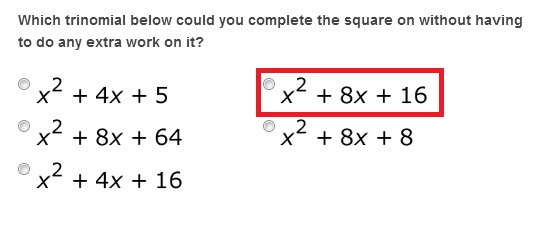
5.
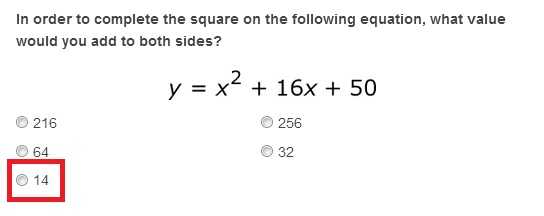
Completing the square can help you learn where the maximum or minimum of a parabola is. If you're running a business and trying to make some money, it might be a good idea to know how to do this! Find out what I'm talking about here.
Mathematics, Economics and Yogurt
I decided pretty early on in my freshman year of college to become a math major, but a little ways in I also discovered that I was really into economics as well. I thought about getting an econ minor but was told that the minor was only two classes less than the major. Well, if I was going to take the time to go through 9 econ classes, why not 11? So I went for it - double major, here I come! And I'm really glad I did, too. It ended up being a breeze because there was enough math in my economics classes to make it hard for everybody else but pretty easy for me.
Anyways, I bring this up because I wanted to share with you a math problem that many of my econ classmates might have gotten stuck on. Here's the scenario: I've decided to hop on the bandwagon and open up a new frozen yogurt chain - you know, the kind where they just let you put whatever you want on it, and then you weigh it at the end?
Well, I know that people are going to want to be able to choose from a lot of different toppings, so having more is probably better. But how many should I have? If I went overboard and bought like 200 different types of toppings, some of them would probably never get eaten and I'd end up losing money.
 |
So this is what economists would do. Using data and theory, they would set up a mathematical model that predicts how much money they'd make with different numbers of toppings. Let's say that, based on how previous yogurt shops had done and how the economy is doing right now, they came up with this: y = -x^2 + 36x - 224, where y is the amount of profit I'll make (in thousands of dollars) and x is the number of toppings I'm going to offer.
Because the biggest exponent on the x is a 2, what we've got here is a quadratic equation, which means our graph will be a parabola. This quadratic is in standard form (y = ax^2 + bx + c), which means we can make a few observations.
The c value will tell us our y-intercept, which means if I were to offer no toppings, or substitute in x = 0, I would end up losing quite a lot of money. Next, the negative a value tells me that this will be a concave down parabola, so I'm guessing that our graph will look something like this. So, this makes sense to me - as I offer more and more toppings, my profit will slowly go up. But eventually I'll reach a point where I'm offering too many toppings and they're not getting eaten, so I start to lose money.
 |
The question is, where is the vertex of this parabola? Well, too bad this function wasn't given to us in vertex form instead of standard form. If it was, I'd know exactly what the profit-maximizing number of toppings was. So how can we change it into the form that we want?
Well, that's exactly what completing the square is: taking a standard form equation like this one (y = ax^2 + bx + c) and changing it into vertex form, like this: y = a(x - h)^2 + k. The main part of the problem comes down to this little guy: (x - h)^2. We call this a perfect square binomial and need to remember that it's not equal to x^2 - h^2, but instead equal to (x - h)(x - h). So if we're trying to change our standard form equation into vertex form, what we need to do is factor the standard form equation into something like this, a perfect square binomial. As is often the case in math, it's all going to come down to pattern.
Finding and Completing the Square
Let's step away from our yogurt problem real quick to a slightly different one with a little bit nicer numbers to make finding the pattern easier - say, (x + 5)^2. Well, that's just (x + 5)(x + 5), which we can FOIL out to be x^2 + 10x + 25.
So what relationship do the numbers in the standard form expression have with each other? Well, it might be a little bit tricky to see, but it turns out that our b value, 10, divided by 2 (which is 5) and then squared turns into our c value, 25. Since we know that this trinomial can be factored into a perfect square binomial, (x + 5)^2, it will turn out that any trinomial where the middle value divided by 2 and then squared is our final value, the c value, will be able to be factored as a perfect square binomial. If we want to say that same thing in math, we're looking for a trinomial with a c value that is equal to (b/2)^2. If that's the case, it can be factored as a perfect square binomial.
So, in order to do this, we need our c value to be a specific number. But when we've got an equation that we can, say, add 20 to both sides of, we can make that c value whatever we want. This allows us to force the c value into being the exact number we need it to be in order to become a perfect square binomial. This process of changing the c value into the exact right number that makes it fit the pattern and become a perfect square binomial is what mathematicians call completing the square.
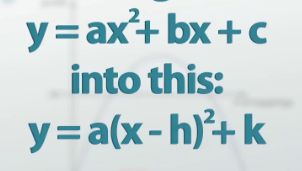 |
Yogurt Profit
Let's see how we would do this with our yogurt problem in order to determine the right number of toppings to offer. We were here - y = -x^2 + 36x - 224 - but now we know that our c value needs to be something specific in order for it to work as a perfect square binomial. What it needs to be is the middle number, 36, divided by 2 (18) and squared (324). Right now our c value is -224, so it's not quite the right number. Our trinomial is not ready to be factored as a perfect square binomial... yet.
What we can do is use inverse operations on both sides of the equal sign to turn it into that number that we need, 324. Now, this is actually kind of a strange example and because we have this negative sign, a negative a value, we actually need our c value to be -324. So if I want the c value to be -324, and right now it's -224, I simply need to make it 100 smaller. That means we can subtract 100 from both sides of the equation, giving us this: y - 100 = -x^2 + 36x - 324. Now that our c value is the exact right value that it needs to be, we can factor it into a perfect square binomial.
First let's take this negative sign out of everything, dividing that out, putting it in front and then changing the sign on everything else. And now we need to factor the trinomial on the inside of the parentheses, (x^2 - 36x + 324). Finding two numbers that multiply to 324 and add up to -36 might be a little hard to find, but eventually we'd come to -18 and -18. The fact that they are both the same number and also equal to one half of 36 means that we're on the right track!
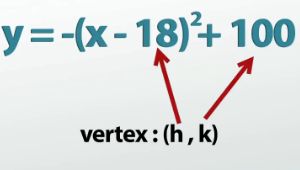 |
Once we've found those two numbers, we can factor the expression and rewrite it as this: y - 100 = -(x - 18)(x - 18), and then because they're both the same, we can combine them into one and change it into this: y - 100 = -(x - 18)^2. We have now completed the square! We took a trinomial and turned it into a perfect square binomial. One last step to change it into vertex form means adding the -100 back over to the other side of the equation, and we now have our vertex form, y = -(x - 18)^2 + 100. Remembering that the h and k values of vertex form tell us where the vertex is, the vertex of our parabola was at (18, 100). That means that 18 is the optimal number of toppings to sell, and I'll make $100,000 if I do that. Hmm, maybe I should rethink being a teacher...
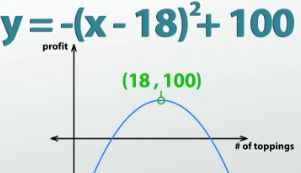 |
Completing the square can be really hard to see at first, and it's probably one of the most complicated things you'll need to learn in an algebra class. Now that you know the general idea, it's probably a good bet to check out the later lesson where we'll focus on the process and do some practice problems.
Lesson Summary
Completing the square turns a quadratic equation in standard form (y = ax^2 + bx + c) into one in vertex form (y = a(x - h)^2 + k). A trinomial can be factored into a perfect square binomial as long as the c value is equal to (b/2)^2, which means that if your trinomial's c value isn't naturally equal to what you want it to be, you can complete the square by performing operations on both sides of the equation to force the c value into being exactly what you want it to.